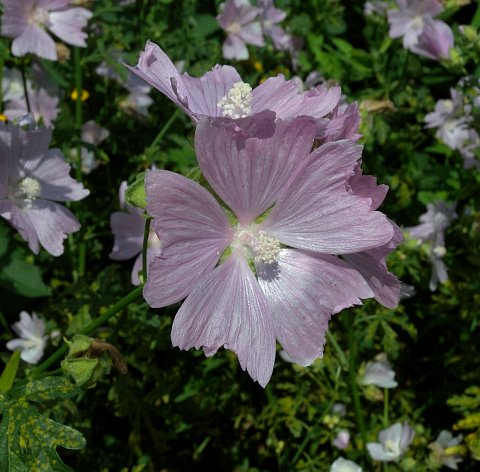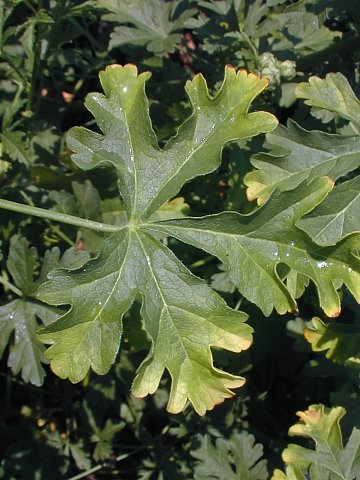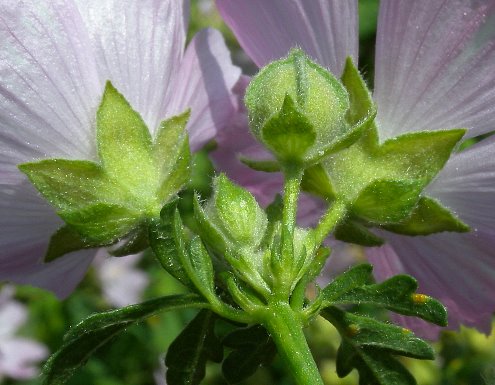
The upper and lateral stems terminate in clusters of flowers. Each flower is 1½-2½" across, consisting of 5 white to pink petals, 5 light green sepals, and a white columnar structure with the reproductive organs. Individual petals are obcordate-obdeltate with somewhat ragged outer margins; sometimes they have fine radiating veins that are rosy pink. The sepals are about one-third the length of the petals, ovate in shape, and densely pubescent; they are joined together at the base. Underneath the sepals of each flower, there are 3 sepal-like bracts that are ovate in shape and densely pubescent; they are a little shorter than the sepals. Pedicels and peduncles of the flowers are light green, densely pubescent, and rather short (less than 2" in length). The blooming period occurs during the summer for 1-2 months. Individual flowers are short-lived. Each flower is replaced by a ring of mericarps (hardened structures containing one or more seeds). For this species, each mericarp contains a single seed. The mericarps are about ¼" long, reniform, and hairless. This plant reproduces by reseeding itself.
Cultivation: The preference is full or partial sun, moist to dry-mesic conditions, and soil containing loam or sandy loam. The leaves often become yellowish in response to hot dry weather and they are occasionally damaged by foliar disease.

Range & Habitat: The introduced Vervain Mallow has reportedly naturalized in Kane County of NE Illinois (see Distribution Map). However, some naturalized populations of Malva moschata (Musk Mallow) within the state may be Vervain Mallow instead, as these two similar species are often confused with each other. Vervain Mallow was introduced into North America from Eurasia as an ornamental garden plant. It is still cultivated in gardens, from where it rarely escapes. Habitats of naturalized populations consist of roadsides and waste areas where there is a history of disturbance.
Faunal Associations: According to Müller (1873/1883) in Germany, the flowers of Vervain Mallow are visited primarily by honeybees, Andrenid bees, and other bees. He also reported bee flies (Bombyliidae) and skippers as floral visitors. These insects obtained primarily nectar from the flowers. Some insects feed destructively on the foliage and other parts of Vervain Mallow and other Malva spp. (mallows). These insect feeders include Aphis gossypii (Cotton Aphid) and the caterpillars of the following butterflies, skippers, and moths: Strymon melinus (Gray Hairstreak), Vanessa cardui (Painted Lady), Pyrgus communis (Checkered Skipper), Anomis erosa (Yellow Scallop Moth), and Rachiplusia ou (Gray Looper Moth).

Photographic Location: A garden in Urbana, Illinois.
Comments: Vervain Mallow is very similar in appearance to another mallow that is often cultivated, Musk Mallow (Malva moschata). Vervain Mallow differs from the latter species by having leaves that are less deeply lobed, floral bracts that are ovate in shape rather than oblong-linear, and mericarps that have hairless outer sides rather than pubescent sides. Another species, High Mallow (Malva sylvestris), differs from the preceding mallows by having leaves that lack secondary lobes and its flowers are often a deeper shade of pink or purple. All of these Eurasian species have attractive flowers.